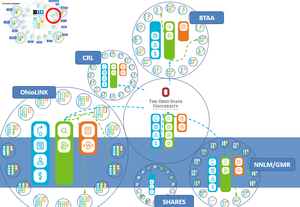I finished off my presentation for the Celtic Connections conference last week in a local Starbucks with a wireless connection. This was in the middle of Cardiff. It was buzzing.
Stuck for several hours in Newark airport on my way back from Cardiff, I was interested to read the cover story about Starbucks in USA Today. They plan to leverage the brand to make Starbucks a central media venue.
The kingpin of pricey coffee is intent on ranking among the top trendmeisters before the decade is out. Something like: If you love the taste of our coffee, you’ll love our taste in pop culture, too. “Call it the Starbuckization of society,” says George Ritzer, sociology professor at the University of Maryland. “Starbucks has created the image that they’re cutting edge.” [USATODAY.com – Starbucks aims beyond lattes to extend brand]
I was interested to see those ‘discover’ and ‘deliver’ verbs, familiar to readers of these pages.
“We are in a unique position to transform the way music is discovered and delivered,” Lombard says. [USATODAY.com – Starbucks aims beyond lattes to extend brand]
And my modest prediction of a while ago, comes to pass.
It also is testing in a few sites a plan to make stores what Schultz calls “digital fill-up” stations for entertainment downloads. By ramping up Wi-Fi networks already in more than half its stores, Starbucks could offer not only a place to check e-mail on a laptop but also load an MP3 player. “People are using our stores in ways we never imagined,” he says. [USATODAY.com – Starbucks aims beyond lattes to extend brand]
Some years ago, when we were moving to London, we soon realized that if we saw a Starbucks or a Pizza Express we could not afford the area.
Starbucks is influencing urban streetscapes. In brochures for high-end apartments near New York City, it’s not uncommon to see “near Starbucks” as a selling point. A Starbucks in the neighborhood is “definitely an indication that an area has arrived,” says Doug Yearley, a regional president with builder Toll Brothers, now putting up luxury condos near a Starbucks in Hoboken, N.J. [USATODAY.com – Starbucks aims beyond lattes to extend brand]
I find this intriguing as it is a good example (among others) of the power of brand in our hybrid world of network and place. And of how Starbucks is leveraging that brand, and its position as a provider of ‘on-demand place’ and connect time to support the ‘flow’ of (some) current lifestyles.
It seems to me that the role of the coffee house, and it must be said, Starbucks in particular given its reach, in the contemporary urban setting is becoming clearer. Starbucks provides time-place alignment in busy, moving lives: in other words it provides ‘on-demand place’. It provides a place which is convenient at the time that it is required. This may be for downtime (a place to spend time relaxing), connect-time (a place to spend time connecting to the network), rendezvous time (a place to spend time with others), work-time (a place to spend time working). A colleague recently described Starbucks to me as his mobile office when he was on the road. It is not unusual to see job interviews take place there. [Lorcan Dempsey’s weblog: Starbucks and other coffee houses – an observation and a prediction]
Incidentally, in my Cardiff presentation [ppt] I talked about the OCLC Perceptions report, focusing in particular (thanks to data supplied by my marketing colleague Joanne Cantrell) on UK results. For reasons we have not explored, UK respondents were generally less positive about library experiences and perceptions than respondents in other countries (the results here are largely based on perceptions of public libraries). The library web presence did not make a big impact. And, on the network, brand is very important.
Nor do you have the benefit of familiar architectural cues; the dignified stone facade of the local branch bank, for example, with its comforting intimations of solidity, permancence, and reliability, is replaced by the interface of an online home banking or financial management system. So, as Internet marketeers quickly figured out, trusted brand names and brokers play an increasingly crucial role. For organizations with goods and services to offer, maintaining brand equity on the information superhighway serves essentially the same purpose – in a much larger context – as maintaining conspicuous premises on Main Street. [e-topia: “Urban life, Jim – but not as we know it”. p88]
Related entries:



